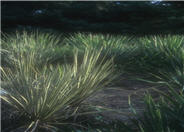
Common name:Soapweed
Botanical name:Yucca glauca
This clumping evergreen yucca has narrow leaves and a startling, 3- to 4 foot tall flower stalk. The fragrant flowers are pale green or greenish white. It is a tenacious weed in areas of the American West, but adds a touch of the desert to gardens. Soap can be made from its roots and the foliage is used in basket-making.

Common name:Amur Maple
Botanical name:Acer ginnala
Amur maple is a relatively small tree or large shrub, generally multi-stemmed, with deeply lobed, palmate leaves. There is a great deal of variability due to a wide range of seed source and grafting stock. This may make it a little tough to predict size and fall color, the two characteristics that make this a stand-out selection for a smaller landscape or parkstrip. If those characteristics are very important to you, shop for plants in the fall, when you can see both it's color and judge its growth rate. Figure about 18 to 25 feet tall and wide.
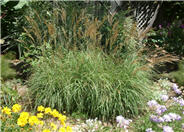
Common name:Japanese Silver Grass, Maiden grass
Botanical name:Miscanthus sinensis
Miscanthus is a large group of ornamental grasses ranging from a few feet to over 7 or 8 feet tall. Blade colors range from solid green, to green with silver mid-ribs, to variegated forms. Plumes are generally held well above foliage clumps, appearing in late summer to early fall, depending on the variety, and may be cut for fresh or dry arrangements.
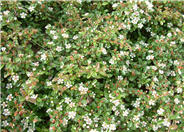
Common name:Bearberry Cotoneaster
Botanical name:Cotoneaster dammeri
Bearberry cotoneaster is a semi-evergreen shrub that grows about 1.5 feet tall and 6 feet wide. It has a prostrate habit and makes a dense groundcover. It has dark green, ovate to rounded leaves with prominent veins. Small white flowers appear in spring, followed by small, bright red berries that persist into winter. This is a great plant for banks or hillsides as long as it gets full sun. It becomes drought tolerant once it's established. There are several cultivars in the trade, each with its own special qualities.
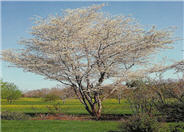
Common name:Apple Serviceberry
Botanical name:Amelanchier x grandiflora
A hybrid between A. arborea and A. laevis, the new leaves of this species have the pubescent foliage of the former and the purplish cast of the later. Summer foliage is a soft green, turning orange to scarlet in the fall. This hybrid has larger and showier flowers then either parent. Numerous cultivars have been selected from this species, including 'Princess Diana,' 'Prince William,' and 'Cole's Select.' Generally 18 to 25 feet tall and about half as wide. Grown as both a single or multi-stemmed small tree or shrub. Lovely as a specimen or in masses.
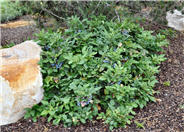
Common name:Creeping Mahonia
Botanical name:Mahonia repens
The creeping Mahonia is a low-growing shrub with a creeping habit, making it well suited as an understory groundcover. It grows about 12 to 15 inches tall and spreads 3 to 4 feet, though, due to its stoloniferous ways, will slowly spread wider. It has spiny, holly-like foliage that emerges red and matures to a dull green; though evergreen, leaves take on a bronzy-purple fall hue. Yellow, fragrant flowers bloom April and May, and are followed by berries that ripen purple in the fall and persist all winter. Exceptional four-season beauty. There are some planted at the Greater Avenues Water Conservation Garden.
| Designer: Landmark Design | Mark's Place 18 |
Photographer: GardenSoft |
Water Saving Tip:
Fix leaking sprinklers, valves, and pipes.
One broken spray sprinkler can waste 10 gallons per minute - or 100 gallons in a typical 10 minute watering cycle.
